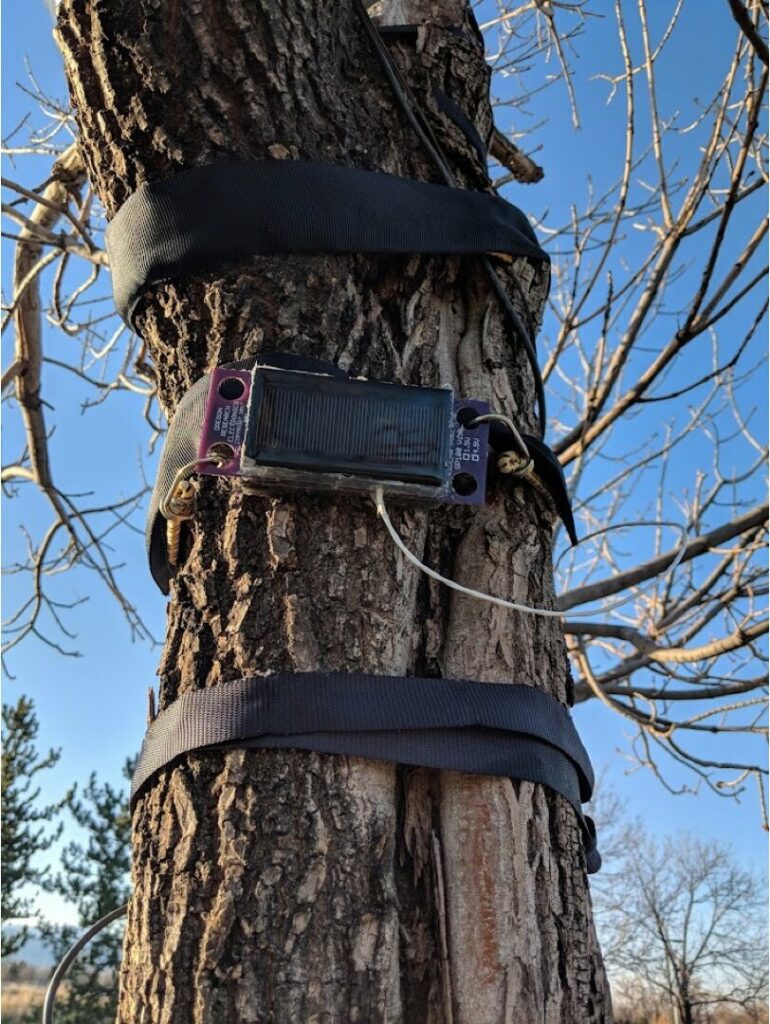Study: trees outfitted with accelerometers could be the future of arborism, agriculture.
Low-cost “tree fitbits” can pinpoint the precise timing of tree activities, like spring bloom or autumn leaf change, according to a new CU Boulder study. Researchers outfitted two East Boulder ash trees with high-resolution accelerometers, efficiently tracking how the trees responded to changing seasons. And in the coming years, arborists could efficiently monitor trees by the thousands with this technology—ultimately giving researchers insight into how tree phenology is changing with a warming climate.

“Accelerometers are in cars, smartphones and fitbits—they track movement in real time. When we put them on trees, accelerometers detect vibrations on the trunk as the tree sways in the wind,” said Deidre Jaeger, recently minted CIRES PhD researcher and lead author of the study out this week in Agricultural and Forest Meteorology. “That sway corresponds to the tree’s mass, which tells us what the tree is doing.”
A tree’s mass all depends on its water uptake throughout the seasons, creating the structural differences that determine how it dances in the wind. In the winter, trees are dry and brittle. “Think of the quick, shaky rattling sound of leafless trees in the dead of winter,” Jaeger said. “Now think of spring: the trees are lush with leaves, full of water, and sway with flexibility.”
A previous accelerometer study was able to detect when trees’ leaf buds opened or when leaves dried and fell off—but Jaeger’s team proved how much more detailed data such tree fitbits can collect. The team picked up the precise moment when white ash trees flowered, catching the subtle change in movement that corresponded to the trees blossoming and pollen release.
Jaeger and her team outfitted two white ash trees on CU Boulder’s East Campus in 2018, working with CU Boulder arborist Vince Aquino to strap equipment to the trunk of each tree. “Previous work suggested trees would need to be out in the open to have enough wind to sway, but we found it not only works on trees inside a city—it’s actually an ideal way to track urban tree growth,” said Jaeger.
Satellite-based, remote sensing tracking methods are useful for monitoring greenness changes in forests dominated by a single species, but it’s hard to learn about a tree species within the city because of the high diversity of species contained within each city block, the team says. Time-lapse cameras also aren’t ideal: they are expensive and raise privacy concerns in populated areas. And while drone imagery can provide high-resolution imagery, getting permission to do daily or weekly fly-overs would be unsustainable. “Accelerometers are discrete, continuous and unaffected by the action or physical barriers a city environment presents. We get high-res, reliable data.”
“Now that we know accelerometers can determine flowering dates, that could be useful in agriculture, predicting when tree fruit may ripen or knowing when to apply interventions to protect tree buds from extreme weather,” Jaeger said. The technology could also forecast when leaves change color in the fall, measure how much snow sits in forest canopies, or even detect tree damage from bugs.
“Trees are also bioindicators of climate change,” Jaeger said, “So having high-resolution, long-term accelerometer data would help scientists better anticipate how a changing climate will impact tree bloom, tree health and beyond.”
Read the paper: Agricultural and Forest Meteorology
Article source: University of Colorado at Boulder
Image credit: jusuf111 / Pixabay








